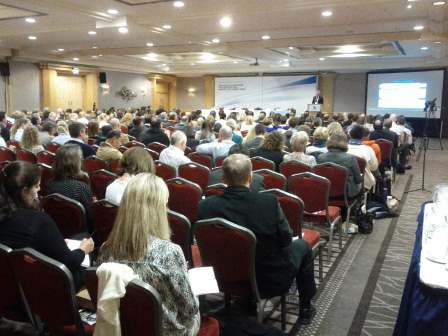Photo right: Australian Haemophilia Physiotherapists: Cameron Cramey and Abi Polus
CAMERON CRAMEY
Cameron Cramey is the Senior Musculoskeletal Physiotherapist at the Royal Adelaide Hospital
Belfast, Northern Ireland, hosted the 14th International Musculoskeletal Congress over four days in May this year. Attended by over 300 delegates from more than 40 different countries this Congress provides an opportunity for health professionals to learn, listen and debate current best practice and future research directions relevant to haemophilia.
Nestled along the banks of the River Lagan, perhaps most famous for being the location for the construction of The Titanic, the Hilton Hotel was the venue for this year’s Congress. With an emphasis on ‘best available evidence’, the Congress covered wide ranging musculoskeletal issues related to haemophilia. Some of the highlights from the Congress included discussion about the ever expanding use of 'outcome measures'; the developing use of ultra-sound in haemophilia; some new research around individual variations in joint bleeding patterns; the safety of radio-active synovectomy; and some lively debate about the role of joint replacement surgery for ankle haemarthrosis.

Session at the Musculoskeletal Congress

Reliving the Titanic in Belfast
Outcome measures are regularly used by health professionals to help monitor how people are managing or coping with their haemophilia. Some measures you may be familiar with include the Haemophilia Joint Heath Score (HJHS), self- reported questionnaires, and regular imaging including x-ray and MRI. We heard from a range of speakers discussing the pros and cons of a wide range of tools used as outcome measures. It was agreed that the use of these measures play an important role in optimising the management and quality of life for people with haemophilia. So although they can be pesky, taking the time to complete questionnaires and doing annual HJHS with your physiotherapists is valuable for both you and your haemophilia treatment team.
Many of you may be used to having regular x-ray (or MRI) to help monitor the health of your joints. Several Haemophilia Centres around the world are now starting to incorporate the use of ultra-sound as part of their annual patient reviews to perform this valuable monitoring. We heard from several speakers who discussed the reliability and usefulness of this relatively affordable and quick screening tool to assist with: joint health monitoring; and management of acute or chronic joint bleeds and synovitis. It appears to be a positive development to supplement existing management approaches and some of you may begin to see your Haemophilia Treatment Centre (HTC) beginning to use more ultra-sound to aid in the management of your haemophilia.
We know that people with haemophilia who have recurrent joint bleeds are susceptible to developing early joint damage known as haemarthrosis. Why some people with haemophilia are more affected than others is not really known, however some developing research coming out of the Netherlands suggests that this variation could be attributable to how each person’s body responds to the inflammatory process that occurs during a joint bleed. Research is currently underway to further understand this inflammatory response to see if more targeted treatment could be developed. But in the meantime, remember to contact your HTC for review following any joint or muscle bleed.
Sometimes people with haemophilia suffer from recurrent joint bleeds or ongoing joint swelling (without active bleeding) due to inflammation and thickening of their joint lining (synovium). In particularly persistent cases removal of the synovium is required (synovectomy). Radiosynovectomy involves the injection of a radio-active material (different material used depending on which country you live in) to remove the synovium rather than doing it surgically. Despite debate amongst the European and American HTCs about which material is best to use, the consensus amongst all centres is that the use of radiosynovectomy is considered safe and a good alternative to surgical synovectomy.
Many of us will know someone with haemophilia who has had an ankle fusion to help control bleeding or pain. In recent times ankle replacements have emerged as an option to help control bleeds and pain, with the aim of also optimising function and preserving movement. Due to the relatively recent development of ankle replacement surgery, not much is known about the long term results of this type of surgery. There was much lively debate amongst the orthopaedic surgeons who attended the Musculoskeletal Congress over the pros and cons of ankle replacement compared with ankle fusion. Emerging evidence suggests that both provide good patient outcomes and the decision for selecting one over the other should be discussed with the patient and their HTC team.
The Congress concluded with a farewell dinner and drinks at the Titanic Belfast with a chance to wander through the Titanic museum; a fitting way to end an informative four days in Belfast. A big thank you to the HFA for providing me with this valuable learning experience and opportunity to meet and discuss current management practice in HTCs from across the world. Ongoing research will hopefully allow us to continue to improve our management of the musculoskeletal issues associated with haemophilia, and participation in these international conferences will help ensure Australian HTCs remain up to date with international best practice.
Haemophilia Foundation Australia acknowledges the Traditional Owners and Custodians of Country throughout Australia, the land, waters and community where we walk, live, meet and work. We pay our respects to Elders past and present and extend that respect to all Aboriginal and Torres Strait Islander peoples.
Sign up for the latest news, events and our free National Haemophilia magazine